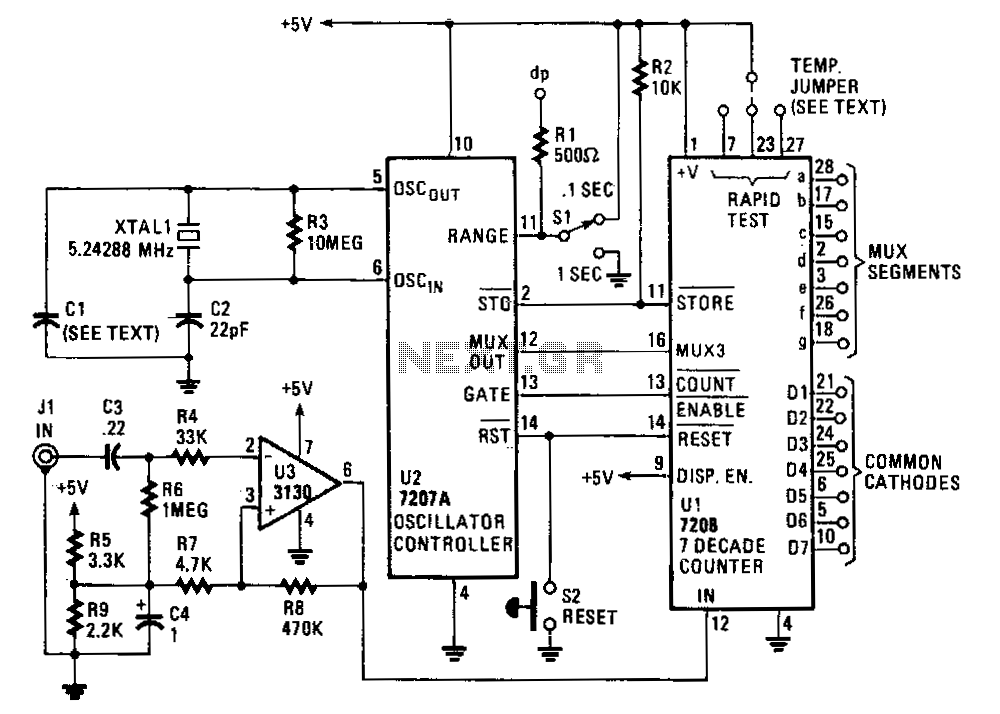
10Mhz-frequency-counter

The circuit comprises an ICM7208 seven-decade counter (U1), an ICM7207A oscillator controller (U2), and a CA3130 biFET operational amplifier (U3). The ICM7208 (U1) counts input signals, decodes them into a 7-segment format, and outputs signals to drive a 7-digit display. The ICM7207A (U2) provides the timing for U1, while the CA3130 (U3) conditions the input to U1. A 5.24288 MHz crystal frequency is divided by U2 to generate a 1280 MHz multiplexing signal at pin 12 of U2. This signal is fed into U1 at pin 16 and is utilized to sequentially scan the display digits.
The circuit design utilizes the ICM7208 as the primary counting and display control component. This integrated circuit is capable of counting up to ten billion counts, making it suitable for a variety of applications requiring high precision and display capabilities. The output from U1 is directly connected to a 7-segment display driver, which translates the binary-coded decimal (BCD) output into a format suitable for visual representation.
The oscillator controller, ICM7207A (U2), plays a crucial role in generating the clock signal necessary for the operation of U1. By employing a crystal oscillator with a frequency of 5.24288 MHz, U2 ensures that the counting operation of U1 remains stable and accurate. The division of this frequency to produce a 1280 MHz multiplexing signal allows for efficient scanning of the display digits, thereby enhancing the visibility and readability of the output.
The CA3130 biFET operational amplifier (U3) is integrated into the circuit to condition the input signals fed into U1. This component is critical for ensuring that the input signals are within the appropriate voltage levels and bandwidth for optimal performance of the counting circuit. The biFET technology used in U3 provides high input impedance and low output impedance, which is beneficial for interfacing with various sensor outputs or other electronic components.
Overall, this circuit is an effective solution for applications requiring precise counting and display of numerical data, utilizing well-established integrated circuits to achieve reliable performance and functionality.The circuit consists of ICM7208 seven-decade counter U1, ICM7207A oscillator controller U2, and CA3130 biFET op amp U3. IC U1 counts input signals, decodes them to 7-segment format, and outputs signals that are used to drive a 7-digit display.
IC U2 provides the timing for U1, while U3 conditions the input to Ul. The 5.24288-MHz crystal frequency is divided by U2 to produce a 1280-MHz multiplexing signal at pin 12 of U2. That signal is input to Ul at pin 16 and used to scan the display digits in sequence. 🔗 External reference
The circuit design utilizes the ICM7208 as the primary counting and display control component. This integrated circuit is capable of counting up to ten billion counts, making it suitable for a variety of applications requiring high precision and display capabilities. The output from U1 is directly connected to a 7-segment display driver, which translates the binary-coded decimal (BCD) output into a format suitable for visual representation.
The oscillator controller, ICM7207A (U2), plays a crucial role in generating the clock signal necessary for the operation of U1. By employing a crystal oscillator with a frequency of 5.24288 MHz, U2 ensures that the counting operation of U1 remains stable and accurate. The division of this frequency to produce a 1280 MHz multiplexing signal allows for efficient scanning of the display digits, thereby enhancing the visibility and readability of the output.
The CA3130 biFET operational amplifier (U3) is integrated into the circuit to condition the input signals fed into U1. This component is critical for ensuring that the input signals are within the appropriate voltage levels and bandwidth for optimal performance of the counting circuit. The biFET technology used in U3 provides high input impedance and low output impedance, which is beneficial for interfacing with various sensor outputs or other electronic components.
Overall, this circuit is an effective solution for applications requiring precise counting and display of numerical data, utilizing well-established integrated circuits to achieve reliable performance and functionality.The circuit consists of ICM7208 seven-decade counter U1, ICM7207A oscillator controller U2, and CA3130 biFET op amp U3. IC U1 counts input signals, decodes them to 7-segment format, and outputs signals that are used to drive a 7-digit display.
IC U2 provides the timing for U1, while U3 conditions the input to Ul. The 5.24288-MHz crystal frequency is divided by U2 to produce a 1280-MHz multiplexing signal at pin 12 of U2. That signal is input to Ul at pin 16 and used to scan the display digits in sequence. 🔗 External reference